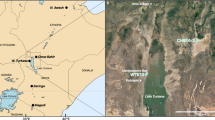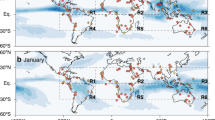Abstract
The distribution of rainfall in tropical Africa is controlled by the African rainbelt1, which oscillates on a seasonal basis. The rainbelt has varied on centennial to millennial timescales along with changes in Northern Hemisphere high-latitude climate2,3,4,5, the Atlantic meridional overturning circulation6 and low-latitude insolation7 over the past glacial–interglacial cycle. However, the overall dynamics of the African rainbelt remain poorly constrained and are not always consistent with a latitudinal migration2,4,5,6, as has been proposed for other regions8,9. Here we use terrestrially derived organic and sedimentary markers from marine sediment cores to reconstruct the distribution of vegetation, and hence rainfall, in tropical Africa during extreme climate states over the past 23,000 years. Our data indicate that rather than migrating latitudinally, the rainbelt contracted and expanded symmetrically in both hemispheres in response to changes in climate. During the Last Glacial Maximum and Heinrich Stadial 1, the rainbelt contracted relative to the late Holocene, which we attribute to a latitudinal compression of atmospheric circulation associated with lower global mean temperatures10. Conversely, during the mid-Holocene climatic optimum, the rainbelt expanded across tropical Africa. In light of our findings, it is not clear whether the tropical rainbelt has migrated latitudinally on a global scale, as has been suggested8,9.
This is a preview of subscription content, access via your institution
Access options
Subscribe to this journal
Receive 12 print issues and online access
$259.00 per year
only $21.58 per issue
Buy this article
- Purchase on Springer Link
- Instant access to full article PDF
Prices may be subject to local taxes which are calculated during checkout


Similar content being viewed by others
References
Nicholson, S. E. The nature of rainfall variability over Africa on time scales of decades to millenia. Glob. Planet. Change 26, 137–158 (2000).
Gasse, F., Chalié, F., Vincens, A., Williams, M. A. J. & Williamson, D. Climatic patterns in equatorial and southern Africa from 30,000 to 10,000 years ago reconstructed from terrestrial and near-shore proxy data. Quat. Sci. Rev. 27, 2316–2340 (2008).
Tjallingii, R. et al. Coherent high- and low-latitude control of the northwest African hydrological balance. Nature Geosci. 1, 670–675 (2008).
Schefuß, E., Schouten, S. & Schneider, R. R. Climatic controls on central African hydrology during the past 20,000 years. Nature 437, 1003–1006 (2005).
Tierney, J. E. et al. Northern hemisphere controls on tropical southeast African climate during the past 60,000 years. Science 322, 252–255 (2008).
Mulitza, S. et al. Sahel megadroughts triggered by glacial slowdowns of Atlantic meridional overturning. Paleoceanography 23, PA4206 (2008).
deMenocal, P. et al. Abrupt onset and termination of the African humid period: Rapid climate responses to gradual insolation forcing. Quat. Sci. Rev. 19, 347–361 (2000).
Haug, G. H., Hughen, K. A., Sigman, D. M., Peterson, L. C. & Rohl, U. Southward migration of the intertropical convergence zone through the Holocene. Science 293, 1304–1308 (2001).
Yancheva, G. et al. Influence of the intertropical convergence zone on the East Asian monsoon. Nature 445, 74–77 (2007).
Frierson, D. M. W., Lu, J. & Chen, G. Width of the Hadley cell in simple and comprehensive general circulation models. Geophys. Res. Lett. 34, L18804 (2007).
Braconnot, P. et al. Results of PMIP2 coupled simulations of the mid-Holocene and Last Glacial Maximum - Part 1: Experiments and large-scale features. Clim. Past 3, 261–277 (2007).
Stouffer, R. J. et al. Investigating the causes of the response of the thermohaline circulation to past and future climate changes. J. Clim. 19, 1365–1387 (2006).
Braconnot, P. et al. Results of PMIP2 coupled simulations of the mid-Holocene and Last Glacial Maximum - Part 2: Feedbacks with emphasis on the location of the ITCZ and mid- and high latitudes heat budget. Clim. Past 3, 279–296 (2007).
Garcin, Y., Vincens, A., Williamson, D., Buchet, G. & Guiot, J. Abrupt resumption of the African monsoon at the Younger Dryas–Holocene climatic transition. Quat. Sci. Rev. 26, 690–704 (2007).
Kim, J. H., Schneider, R. R., Mulitza, S. & Muller, P. J. Reconstruction of SE trade-wind intensity based on sea-surface temperature gradients in the Southeast Atlantic over the last 25 kyr. Geophys. Res. Lett. 30, 2144 (2003).
Castaneda, I. S. et al. Wet phases in the Sahara/Sahel region and human migration patterns in North Africa. Proc. Natl Acad. Sci. USA 106, 20159–20163 (2009).
Maley, J. The African rain forest vegetation and palaeoenvironments during late Quaternary. Clim. Change 19, 79–98 (1991).
Schefuß, E., Ratmeyer, V., Stuut, J-B. W., Jansen, J. H. F. & Sinninghe Damsté, J. S. Carbon isotope analyses of n-alkanes in dust from the lower atmosphere over the central eastern Atlantic. Geochim. Cosmochim. Acta 67, 1757–1767 (2003).
Bird, M. I. et al. Terrestrial vegetation change inferred from n-alkane δ13C analysis in the marine environment. Geochim. Cosmochim. Acta 59, 2853–2857 (1995).
Shanahan, T. M. et al. Paleoclimatic variations in West Africa from a record of late Pleistocene and Holocene lake level stands of Lake Bosumtwi, Ghana. Palaeogeogr. Palaeoclimatol. Palaeoecol. 242, 287–302 (2006).
Gasse, F. Hydrological changes in the African tropics since the Last Glacial Maximum. Quat. Sci. Rev. 19, 189–211 (2000).
Maley, J. Last Glacial Maximum lacustrine and fluviatile formations in the Tibesti and other Saharan mountains, and large-scale climatic teleconnections linked to the activity of the subtropical jet stream. Glob. Planet. Change 26, 121–136 (2000).
Salzmann, U. & Waller, M. The Holocene vegetational history of the Nigerian Sahel based on multiple pollen profiles. Rev. Palaeobot. Palynol. 100, 39–72 (1998).
Salzmann, U. & Hoelzmann, P. The Dahomey Gap: An abrupt climatically induced rain forest fragmentation in West Africa during the late Holocene. The Holocene 15, 190–199 (2005).
Dupont, L. M., Behling, H. & Kim, J-H. Thirty thousand years of vegetation development and climate change in Angola (Ocean Drilling Program Site 1078). Clim. Past 4, 107–124 (2008).
Chase, B. M. & Meadows, M. E. Late Quaternary dynamics of southern Africa’s winter rainfall zone. Earth Sci. Rev. 84, 103–138 (2007).
O’Gorman, P. A. & Schneider, T. The hydrological cycle over a wide range of climates simulated with an idealized GCM. J. Clim. 21, 3815–3832 (2008).
Niedermeyer, E. M. et al. Orbital- and millennial-scale changes in the hydrologic cycle and vegetation in the western African Sahel: insights from individual plant wax δD and δ13C. Quat. Sci. Rev. (in the press) (corrected proof).
Still, C. J. & Powell, R. L. in Isoscapes: Understanding Movement, Pattern, and Process on Earth Through Isotope Mapping (eds West, J. B., Bowen, G. J., Dawson, T. E. & Tu, K.) (Springer, 2010).
Acknowledgements
We thank A. Govin, H. Renssen and C. Li for comments and discussion. This work was supported by ESF—EUROMARC project ‘RETRO’ and the DFG Research Centre/Cluster of Excellence ‘The Ocean in the Earth System’. AMS dating on the core GeoB9535-4 carried out in Peking University was supported by the NSFC (40776028) and the Fok Ying Tong Education Foundation (111016) and datings carried out in Kiel were supported by the Alexander von Humboldt Foundation.
Author information
Authors and Affiliations
Contributions
Experimental work was carried out by J.A.C., E.S., M.Z., R.T., E.H., J.T., A.M. and M.Z. Data analysis and interpretation were carried out by J.A.C., S.M., E.S., D.H., M.P., T.M.D., M.S. and G.W.
Corresponding author
Ethics declarations
Competing interests
The authors declare no competing financial interests.
Supplementary information
Supplementary Information
Supplementary Information (PDF 1081 kb)
Rights and permissions
About this article
Cite this article
Collins, J., Schefuß, E., Heslop, D. et al. Interhemispheric symmetry of the tropical African rainbelt over the past 23,000 years. Nature Geosci 4, 42–45 (2011). https://doi.org/10.1038/ngeo1039
Received:
Accepted:
Published:
Issue Date:
DOI: https://doi.org/10.1038/ngeo1039
This article is cited by
-
Pleistocene drivers of Northwest African hydroclimate and vegetation
Nature Communications (2022)
-
Drivers of the evolution and amplitude of African Humid Periods
Communications Earth & Environment (2021)
-
Synchronous rise of African C4 ecosystems 10 million years ago in the absence of aridification
Nature Geoscience (2019)
-
Palaeo- and rock magnetic investigations of Late Quaternary sediments from the Upper Congo deep-sea fan: on the difficulty in obtaining palaeomagnetic secular variation records from low latitudes
International Journal of Earth Sciences (2019)
-
Consistently dated Atlantic sediment cores over the last 40 thousand years
Scientific Data (2019)



